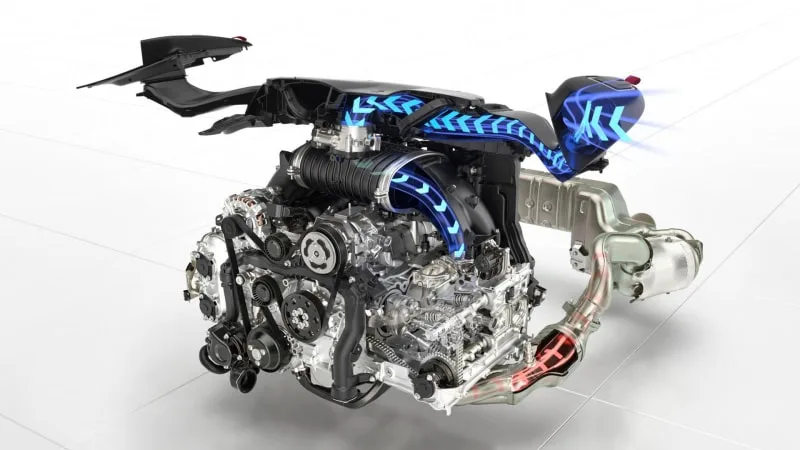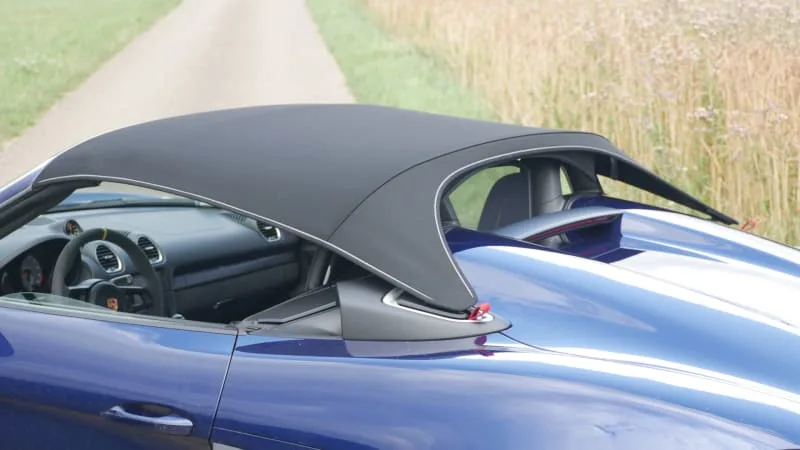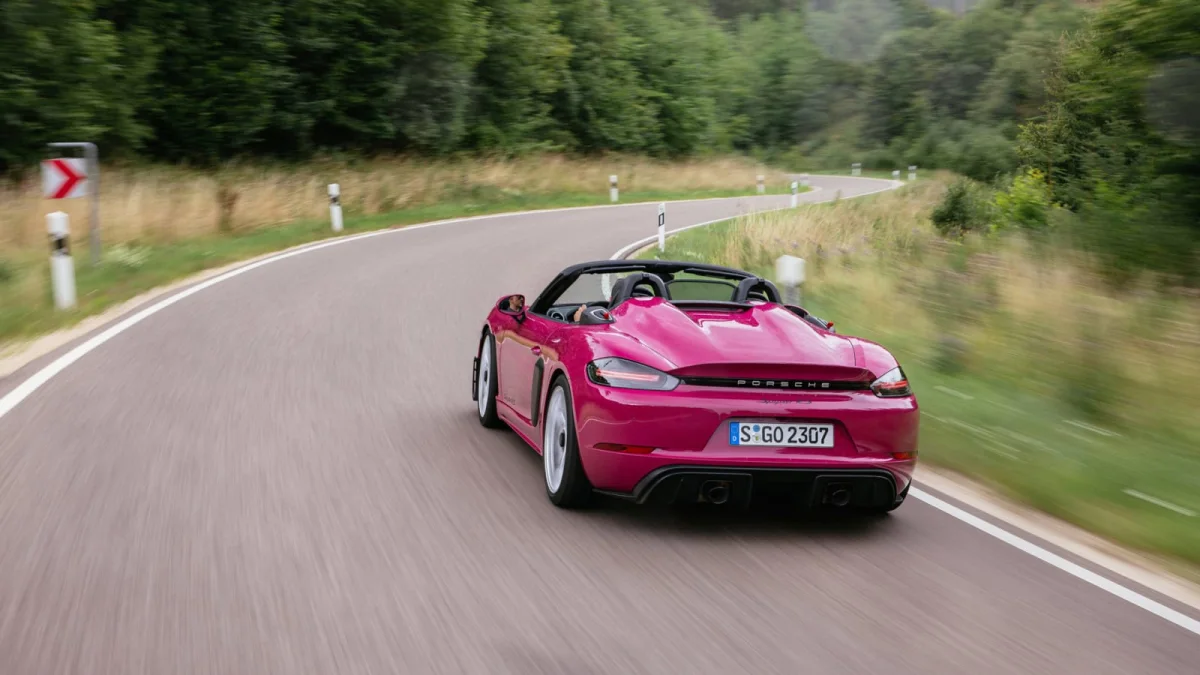ÖDENWALDSTETTEN, Germany – Someday, when all the new cars waft silently along on electricity, high upon the list of internal combustion cars we actually miss will be the Porsche 718 Spyder RS. Its 4.0-liter naturally aspirated boxer six-cylinder keeps revving and revving and revving until the center-mounted tach reads 9,000. It’s already produced 493 horsepower by that point, summoned by throttle response virtually unmatched in an era dominated by forced induction.
Then there is the sound. Good grief, the sound. Mounting an engine a few inches from your kidneys is one thing, as is the case in every 718. Placing an extra set of air intakes a few inches from your ears is quite another, but that’s also the case in the Cayman GT4 RS. The Spyder RS goes even further by removing the glass and metal that separates your ears from those intakes in the GT4 RS. Even with the top on the Spyder RS, there can still be nothing between those intakes and your fragile cochlea … but more on that unique roof later.
Many cars sound better on the outside than behind the wheel thanks to exuberant exhausts and abundant sound deadening. The Spyder RS? It’s hard to even hear the dual-note exhaust over the engine. The shrieking wail that’ll have you leaving a pack of ear plugs in the glovebox for passengers (not an exaggeration, this is definitely a good idea), is so raw, invigorating and unique that the exhaust is more like a bass player adding some deeper background tones to the overall song.
The noise is also why you buy the 718 Spyder RS. If you want to go really fast and take full advantage of the 718’s mid-engined layout, the Cayman GT4 RS is the sharper tool. If you want an experience, regardless of where you’re going or how fast you’re traveling, the Spyder is the choice. Roof on, roof off, roof kind of on and off … there’s even a versatility to that experience. But again, more on that roof later.
The engine making all that fuss is shared with the GT4 RS as well as the 911 GT3 Cup racing car: a screaming naturally aspirated 4.0-liter flat-six good for 493 hp, 331 pound-feet of torque and a 0-60 time of 3.2 seconds. While that output is slightly less than the 911 version, it’s only because of the difference in exhaust length due to the mid-engine placement. The seven-speed PDK automatic is obligatory, and since you’re already asking.
“No, it’s not coming with a manual,” said Andreas Preuninger, the director of Porsche’s GT model line. “Why not? Because there’s no manual available that we can mount in the (718) platform that can handle the RPM and the torque of the engine. It’s not because we don’t want to, it’s that there’s nothing there.”
Thankfully, PDK is seemingly powered by some sort of mind-reading device, because it so expertly downshifts exactly when and by how many you would that the lovely paddle shifters are basically ornamental.

There’s more here than just a rock concert worth of noise blasting forth from six angry cylinders, though. Compared to the GT4 RS, the Spyder has slightly softer suspension tuning courtesy of lower spring rates and damper rates. Porsche says that’s for the more grand-touring nature of convertibles, but one would imagine it’s also because softer suspension tuning is usually an engineering necessity when lopping off a full roof. Not that anyone would call the Spyder RS ride “soft.” Even on southern Germany’s lovely roads, the odd blemish or manhole cover revealed firm reactions that might get tiresome during a lengthy drive on American pavement. Honestly, I wouldn’t mind this powertrain with a less hardcore everything else.
What is everything else? Well, the GT4 and Spyder RS receive a specific suspension system that’s adjustable and whose various parts are connected to the body via ball joints – a feature, like much of this car, shared with the new GT3 and Porsche race cars. The standard adaptive suspension has two settings, both of which as described above, are firm. That suspension is lowered a full 1.2 inches compared to the 718 Boxster, and although the front-axle lift system is a $3,040 option, the Spyder does benefit from a two-inch shorter carbon fiber splitter than the GT4 RS and therefore slightly better clearance. The shorter splitter is to counteract not having the GT4’s swan-neck wing on the back and balance front/rear downforce. Total downforce is indeed less, but there’s still plenty added thanks to the Spyder RS’ unique ducktail (woo-hoo).
Then there’s the weight savings. The RS weighs an astonishing 59 pounds less than the regular, already lightweight Spyder that, like the standard GT4, has been discontinued. It also weighs 13 pounds less than the GT4 (or 26 if you leave the roof at home), but then, a Boxster is lighter than a Cayman, too. Body panels are carbon fiber, there are lightweight carpets, lighter motors for interior elements, and the engine even happens to be 11 pounds lighter. The unique roof slices off nearly 17 pounds from the regular Spyder’s lightweight roof, which itself was 19 pounds lighter than the standard, power-operated Boxster roof. And if you’re in the mood to chop even more weight, Porsche offers a Weissach Package with magnesium wheels, titanium exhaust pipes and exposed carbon fiber elements throughout the exterior.



All of the unique suspension work results in a degree of balance, precision and any number of other superlatives that describe a car better able to take corners than virtually every other car on the road while communicating with its driver better than virtually every other car on the road. The steering? Chef’s kiss. The thing with the Spyder RS, however, is you don’t actually have to drive all that fast to fully appreciate the experience. There’s so much communication, so much feel and, yep, so much noise, that you can have a memorable time without going anywhere close to its limits. This car is a feast for the senses regardless of what the speedometer says.
Which is good, since we were told that the local polizei are pretty intent on holding the speed limit of 100 km/h applied as a blanket standard throughout this part of southern Germany. That goes for mountain roads you could definitely go faster on as well as mountain roads that make you go, “100, are you nuts?!?” In America, the limits on similar roads would be half that. Either way, the roads allowed us to get a pretty good taste of the Spyder RS’ elevated performance capabilities as well as its superior roadster talents of touring a scenic location with the windows down and the system up. And by system, I mean the engine, because although the car in theory has a stereo, I sure as hell didn’t use it. With 103 decibels pumping behind my left ear at full throttle, I wouldn’t have heard it anyway. That volume, by the way, is labeled “Dangerous” on my decibel reading app. After a solid minute of hard mountain driving, our average of 96 dB is labeled “May be harmful.” Again, earplugs.
Which, finally, brings us to the thing that makes those earplugs necessary. The “roof” is in fact two pieces that must be manually installed on the car: the “bimini” top that’s basically a sunshade draped from windshield header to trunk lid across the roll hoops, and a “weather protector” that fills in the gap between the side windows and behind the roll hoops. Rather than explain how it works, here’s a video of me in Germany putting it on.
Right, so that seems like a pain in the ass, right? Of course it is, especially when the regular Boxster’s roof instructions are as follows: push button. There are benefits to it, though. Besides slashing 35 pounds off the regular Boxster roof (or 48 if you leave the roof at home), this roof design was necessary for those glorious extra intakes, which effectively raise the engine’s height and encroach upon the space normally occupied by the roof. Even the regular Spyder’s lightweight roof, which was less complicated but still a get-out-of-the-car affair, wouldn’t fit. So, if you want that engine and all that noise (and believe me, you do), you gotta live with the roof. Also, a suggested speed limit of 122 mph since the roof isn’t reinforced – it’s just a piece of fabric secured with tension after all. Roof off, you can go 191, so bring a tight-fitting hat.
But you know what? I love this roof. It’s actually better. We spent virtually the entire day with the bimini portion in place and the weather protector in the trunk, thereby achieving the best-of-both-worlds situation of extra air and all that noise without being roasted by the sun and blasted by wind. We even drove in a steady drizzle without a drop entering the cabin. If you live in a place where the sun perpetually shines (as I do, in Southern California), this roof is perfect. That it’s a pain in the ass to fully place is something I’d rarely need to contend with, and there’s plenty of security present as long as you raise the windows.
If the regular Boxster offered this roof option, I’d check that box. And if you could enjoy this engine and all its noise without all the extra go-fast gear, I think Porsche would have some takers for that, too. The company is not shy about mixing and matching in such a way, as the 911 S/T most recently illustrates, so who knows, maybe I’ll get my way. Of course, I’ll need to start saving up since the Spyder RS starts at $162,150, including destination. You could have two Boxster S for that. So yes, this car is just as overwhelming for your wallet as it is for your ears.
